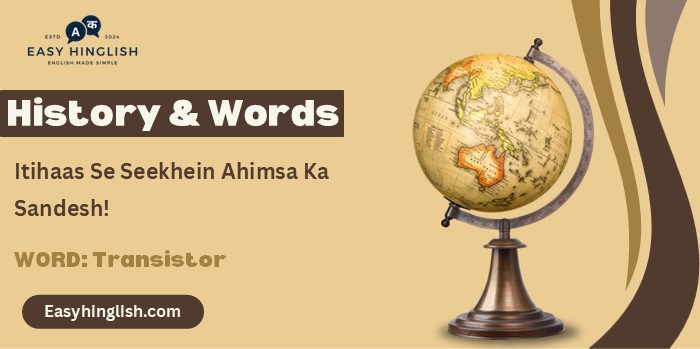History & Words: 'Transistor' (December 14)
Welcome to 'History & Words.' Main Prashant hoon, Wordpandit aur Learning Inc. Network ka sansthapak. Yeh series meri bhasha seekhne ki lagan aur itihas ke prati ruchi ka sangam hai. Har kadi ek shabd aur uss se judi ek tithi par roshni daalti hai, jisse aapka shabdkosh badhta hai aur aap itihas ko gehraai se samajh paate hain. Aaiye, iss safar mein shabdon ke madhyam se samay mein pichhe chalein.
🔍 Aaj ka Shabd: Transistor
Pronunciation: /trænˈzɪstər/ (tran-ZIS-tor)
🌍 Parichay (Introduction)
14 December 1947 ko Bell Labs mein John Bardeen, Walter Brattain, aur William Shockley ne ek aisa demonstration kiya jo modern world ka face completely change kar dega. Unhone first working transistor ka successful operation dikhaya – ek tiny device jo bulky vacuum tubes ka replacement ban jata.
Yeh moment sirf ek scientific breakthrough nahi tha, balki Digital Age ka birth certificate tha. Uss chhote se semiconductor device ne electronics industry ko revolutionize kar diya aur computers, smartphones, internet – jo aaj hamari life ka essential part hain – sabka foundation bana.
Transistor ka invention 20th century ki sabse important technological achievement maani jaati hai. Iss ek discovery ne Information Age ki shuruaat ki aur global communication ko possible banaya. Aaj har electronic device mein billions of transistors kaam kar rahe hain.
🌱 Shabd ka Utpatti (Etymology)
"Transistor" word ka creation khud mein ek interesting story hai. Bell Labs team ne yeh name "transfer resistor" se derive kiya – kyunki yeh device electrical signals ko transfer karta tha while acting as a variable resistor.
Initially "transistor" ke alawa "semiconductor triode" aur "crystal triode" jaise names suggest kiye gaye the. Lekin John Pierce, jo Bell Labs mein kaam karta tha, ne "transistor" suggest kiya kyunki yeh concise aur memorable tha.
Yeh word 1948 mein officially adopt hua, aur jaldi hi global electronics vocabulary ka essential part ban gaya.
📖 Mahatvapurn Shabdavali (Key Vocabulary)
- 🔑 Semiconductor: Material jo conductor aur insulator ke beech ki properties rakhta hai
- 🔑 Vacuum Tube: Electronics mein pehle use hone wala bulky component
- 🔑 Amplification: Weak signals ko strong banane ka process
- 🔑 Silicon: Transistors banane ke liye primary semiconductor material
- 🔑 Integrated Circuit: Multiple transistors ko combine karna ek chip mein
- 🔑 Moore's Law: Transistor density doubling ka prediction har do saal mein
🏛️ Itihasik Sandarbh (Historical Context)
1940s se pehle electronics mostly vacuum tubes par dependent tha. Yeh tubes large, hot, fragile aur power-hungry the. Radio, early computers aur telephone systems mein thousands vacuum tubes use hote the, jo maintenance nightmare create karta tha.
World War II ke time radar technology aur communication systems ki demand ne semiconductor research ko boost kiya. Bell Labs ne solid-state physics mein invest kiya kyunki reliable, compact electronics ki military aur civilian dono needs thi.
Crystal detectors aur semiconductor materials ka study 1930s-40s mein active tha. Quantum mechanics ki understanding ne electron behavior in semiconductors ko explain kiya, jo transistor development ke liye crucial tha.
Bell Labs ka research environment unique tha – pure research aur practical applications ka perfect combination. Bardeen (theoretical physicist), Brattain (experimental physicist), aur Shockley (solid-state expert) ka collaboration interdisciplinary innovation ka classic example tha.

⏳ Samayrekha (Timeline)
- 1904: Fleming valve: first vacuum tube invented
- 1920s: Semiconductor properties ka systematic study
- 1940: Bell Labs semiconductor research program start
- 1945: World War II ends; civilian electronics demand grows
- 14 Dec 1947: First working transistor demonstration
- 1948: Transistor invention publicly announced
- 1956: Bardeen, Brattain, Shockley win Nobel Prize
- 1958: First integrated circuit developed
- 1971: Intel's first microprocessor launched
🌟 Is Din ka Mahatva (The Day's Significance)
14 December 1947 ka din technological history mein ek watershed moment tha. Bell Labs ke Room 1E455 mein jo experiment hua, woh point-contact transistor ka first successful demonstration tha.
Walter Brattain ne germanium crystal par gold contacts place kiye, aur John Bardeen ke theoretical guidance mein amplification achieve kiya. Input signal ko output mein amplify karna – yeh simple concept electronics revolution ka starting point ban gaya.
William Shockley, jo team lead tha, initially disappointed tha ki uska junction transistor concept work nahi kar raha tha. Lekin Bardeen-Brattain ka point-contact approach breakthrough nikla. Shockley ne later junction transistor develop kiya jo mass production ke liye better tha.
Uss din ka lab notebook entry simply mention karta hai: "This circuit was built to test ideas on amplification." Lekin yeh understatement tha – actually modern civilization ka foundation lay ho raha tha.
Demonstration mein speech signals ko amplify kiya gaya, proving ki transistor vacuum tubes ka viable replacement hai. Small size, low power consumption, reliability – yeh advantages immediately clear ho gaye.
💬 Prasiddh Ukti (Quote)
"The transistor was probably the most important invention of the 20th century, and the foundation of the modern information age."
— Gordon Moore, Intel Co-founder
🔮 Aaj Ka Matlab aur Chintan (Modern Usage and Reflection)
Aaj "transistor" sirf ek electronic component nahi – yeh digital civilization ka basic building block hai. Smartphones mein billions of transistors, computers mein trillions, internet infrastructure mein countless – har jagah yeh tiny switches kaam kar rahe hain.
Modern transistors 1947 ke original se millions of times smaller aur faster hain. Nanotechnology ne transistor size ko atomic level tak shrink kar diya hai. 7nm, 5nm, 3nm processes mein transistor density exponentially increase ho rahi hai.
Artificial Intelligence, Machine Learning, Cloud Computing – yeh sab transistor evolution ke bina possible nahi the. Moore's Law still holding hai, aur quantum computing transistor technology ko next level par le jane ki koshish kar rahi hai.
🏛️ Virast (Legacy)
Transistor ka legacy ubiquitous hai – har electronic device mein present. Silicon Valley ka existence, global tech industry ka dominance, digital economy ka rise – sab 14 December 1947 ke breakthrough se trace kiye ja sakte hain.
Bell Labs ka research culture – long-term thinking, interdisciplinary collaboration, fundamental research – aaj bhi innovation hubs ke liye role model hai. Nobel Prize winners, startup ecosystems, tech giants – sabka connection transistor revolution se hai.
🔍 Tulnatmak Vishleshan (Comparative Analysis)
1947 mein transistor ek laboratory curiosity tha – expensive, unreliable, limited applications. Aaj mass production, cost efficiency, aur performance mein astronomical improvement hui hai.
Vacuum tube era mein electronics room-sized machines tak limited tha. Transistor age ne portable electronics, personal computing, aur mobile communication possible banaya. Scale aur accessibility mein revolutionary change aya hai.
💡 Kya Aapko Pata Hai? (Did You Know?)
🎓 Antim Vichar (Conclusion)
"Transistor" sirf ek technical term nahi – yeh modern life ka enabler hai. 14 December 1947 ko jo tiny device demonstrate hua, usne human civilization ko Information Age mein transition kara diya.
Aaj har click, swipe, search mein billions of transistors kaam kar rahe hain. Digital connectivity se le kar artificial intelligence tak, transistor 21st century ki foundation technology hai aur rahegi.
📚 Aage Padhne Ke Liye (Further Reading)
- 📘 The Idea Factory: Bell Labs and the Great Age of American Innovation – Jon Gertner
- 📗 Crystal Fire: The Birth of the Information Age – Michael Riordan & Lillian Hoddeson
- 📙 The Second Machine Age – Erik Brynjolfsson & Andrew McAfee








